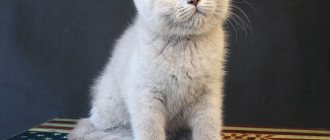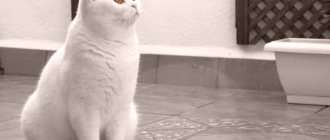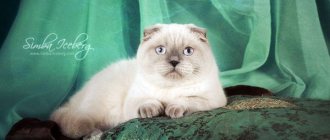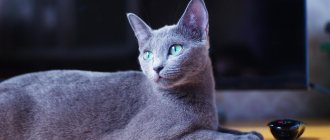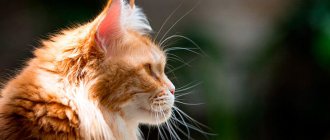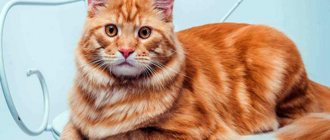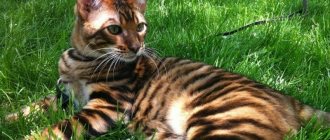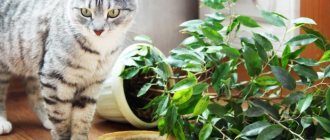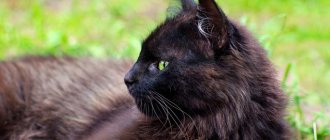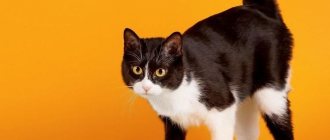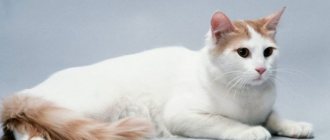History of the Scottish Fold cat breed
Scottish Fold cat
Usually, the appearance of new breeds is preceded by long, targeted selection work. In the case of the Scottish Fold, the situation is different.
The first mention of cats similar to the Scottish Fold is found in literature describing white long-haired cats living in China. At one time, representatives of this breed were even called Chinese - it was believed that they live only in this eastern country.
However, in 1961, the first cat with such a characteristic ear shape was born on a Scottish farm. They named her Susie. The mother of the unusual kitten was an ordinary semi-wild tabby, and the father remained unknown. Among the kittens that Susie regularly brought in were babies with very unusual ear shapes. One of these cats fell into the hands of Mary Ross in 1963. She was given the name Snooks. In her very first litter, Mary discovered a white kitten, whose appearance made it clear to the owner that she might be present at the birth of a new breed. To test her assumptions, she crossed the older kitten with a British Shorthair cat, and Snooks with a British Blue cat. As a result of the experiment, kittens were born, which became the first representatives of the Scottish Fold. The algorithm for breeding the breed was put on a scientific basis by professional breeders and geneticists. It was found that the characteristic lop ear is caused by the presence of a special gene Fd. In the case of the combination FdFd, that is, when both parents had ears folded down, the offspring had very serious problems with the musculoskeletal system. Selection experiments have shown that health complications in kittens can be avoided only if one of the parents has erect ears. Born from animals, one of which had the “fold-eared gene” (Fd), and the other did not (fd), the babies could carry the external characteristics of both a cat and a cat. On this basis, until recently, animals with straight ears were recognized as representatives of the British Shorthair. And only recently, felinologists identified a separate breed, which they called “Scottish Straight” (Scottish Shorthair). These cats have erect ears, and in all other respects they are exact copies of their fold-eared counterparts, which is why, in order to preserve the characteristic features, the Scottish Fold should only be mated with a straight cat.
The breed received official registration in 1994.
Features of color
At exhibitions, strict requirements are put forward for pets. A Briton with a uniform, rich red color is allowed to participate. The hair is uniform throughout its length. The standard allows partial tabby coloring on the forehead in the form of the letter “M”, paws, and tail; inclusions in the form of white wool are rejected. The paw pads and nose are a brick-red, terracotta shade a tone darker than the cat's fur. Eye color is red and yellow.
British shorthair
The British Shorthair cat is characterized by a plush coat, round eyes and small ears. The coat is harsh, dense with a thick, uniformly colored undercoat. Soft is a disadvantage.
Appearance of a Scottish Fold cat
The history of participation of Scottish Fold cats in exhibitions is not so long.
Today, there is one general breed standard that all Scottish Folds must meet. In addition, at major competitions, panels of judges use three types of official standards to evaluate animals: WCF, CFA and TICA. The appearance of a Scottish Fold cat must fully comply with all the requirements of the general breed standard.
Head
Scottish fold cat face
Round, with a strong chin, thick round cheeks and a high forehead. The chin is massive and strong. For adult cats, sagging cheeks are allowed. The nose of a Scottish Fold cat should be wide and short.
Ears
Small to medium in size, with slightly pointed tips. They are located widely on the head. Folds forward and down. A special requirement is that when folded and pressed, they must fit into the contour of the head without protruding beyond its boundaries. There are three types of lop ears:
- single (only the ends are bent);
- double (the entire auricle is bent, the gap between the ears and the head is visible);
- triple (fully pressed, there is a visual effect of the absence of ears).
Eyes
Scottish kitten
Widely spaced and round, large in size. An important point is that the eye color must match the overall color of the animal.
Neck
Scottish Folds are characterized by a fairly short, muscular neck.
Torso and limbs
Scottish Fold cats have a medium-sized body, muscular and strong. Well-developed shoulders and chest are clearly defined. Limbs of medium length with developed muscles. The paws are small and round.
Tail
Size – from medium to long. At the base it is quite wide, gradually tapering to a rounded tip. Movable and flexible.
Wool
The cover is dense, elastic and thick. Due to its high density, it does not adhere to the animal’s body, and it looks fluffy.
Color
The Scottish Fold can have a wide variety of coat tones. The breed standard does not make any specific requirements in this matter. But when judges give marks at competitions, they will necessarily take into account the correspondence of the shade of six to the color of the eyes, nose and paw pads, for example:
- color six white. Eye color – golden or blue. Nose and paw pads are pink;
- the fur is pure black. The eyes are only golden. Nose – black, paw pads – gray or black;
- For a smoky-black color, paw pads that are exclusively black in tone are considered harmonious. The color of the eyes and nose is the same as for the pure black coat.
The variety of colors is one of the features that distinguishes Scottish Folds from other cat breeds, and certain requirements for compliance with the general range are imposed on each representative of the breed.
Scottish Folds are medium-sized cats. The weight of females is from 3.5 to 4.5 kg, males are larger - up to 6 kilograms.
Features of the red color of the British
British ginger cats are Red in color. It provides uniform, deep color from tip to root, without white hairs. Only a slight change in shade is allowed in the area of the forehead, tail, and paws. The nose, eye contour and paw pads should be brick red, and the eyes should be lemon yellow or copper.
Solid color is relatively rare. It is more common in cats than in cats. The breed standard allows only solid color, without spots, tortoiseshell (which combines black and red), tabby (striped). So, for example, a pattern may appear on the body of a red British cat; if there is none, then this color is called red ticked.
Ginger British cats are brave, smart, and afraid of little. They easily learn various commands, within reason. Their freedom-loving nature helps them easily endure the absence of a constantly busy owner. That is why they are called “cats for businessmen.” An important positive feature of fiery British cats is their great patience and endurance, thanks to which they find a common language with children, other kittens, even dogs.
Color of kittens
One of the seven breed standards with the most stringent requirements is the British red coat, also known as “orange.” To obtain such a beautiful shade, breeders have improved the gene line of this breed, thanks to the chromosomes of Persians with a red coat color.
Ginger British kittens can have either short (plush) or long hair. This color is uniform, rich, but still with tabby marks. The breed standard does not require white hairs. A kitten or cat with such a “flaw” is not allowed to participate in exhibitions.
The color of the kittens' coat should be rich, equally bright along the length of each hair, and throughout the entire body, as in the photo below. Also, the cat’s paws and nose should be evenly colored without pigmentation. Only the presence of a vague pattern on the pet’s forehead, as well as half rings on the cat’s paws, is allowed.
There are also strict requirements for the eyes: their color can only be golden, orange, without a green areola. Also, the pads of the paws and the nose of the kittens can be either pure red or brick color.
Photo of Scottish Fold cat
Acquisition of a red Scotsman
When buying a kitten from a nursery, the potential owner should ask what kind of food the breeder gave him, since a sudden change in the menu can cause negative consequences for the young body.
Scottish Fold babies are given food 4 times a day; over time, teenage kittens change their diet to 3 meals a day, and after 8 months they can already be given food only twice a day.
Cats of this breed love to communicate, they really need human company, but they are not annoying. When no one is home, these cats will still come up with something interesting to do.
When their owners are away for long periods of time, furry pets feel sad, and a dog could brighten up their loneliness. Red Scottish Folds are characterized by great affection for their owners; they show them their kindness and tenderness with great zeal.
Before purchasing a young fiery Scotsman, you should take a closer look at him and understand his character. In order for a relationship of mutual understanding to develop with a furry friend, he must be similar in character to the future owner, then you will be able to be friends with the pet and get along well.
It is difficult to argue with the fact that cats are currently the main favorites of the planet. Scottish cats had a hand in achieving this status.
This is a relatively new breed, the history of which goes back about 50 years. The first cat with floppy ears was discovered in Scotland, but for a long time this appearance was considered a defect. Despite the fact that people immediately appeared who appreciated the unique appearance, the breed was denied existence for a long time.
It’s hard to argue with the fact that cats are currently the planet’s main pets.
Everything was decided when Scottish fold cats appeared in the United States, where they became very popular. By 1980, breed standards were established, after which breeders around the world began to strive to breed a certain type of cat. The modern name for the Scottish Fold also appeared.
Personality of the Scottish Fold cat
Oh yeah!
Continue Everyone is well aware of the statement that a dog becomes attached to its owner, and a cat becomes attached to a place. In the case of the Scottish fold, both theses will be absolutely relevant and true.
The starting point for understanding the character traits of the animal is the fact that from the very beginning of the breed, Scottish Fold cats were bred and kept exclusively in domestic conditions. Scottish Folds are typical homebodies who feel great even in city apartments, although periodic walks in the fresh air will in no way harm the pet.
When purchasing a Scottish fold cat, you should take into account that representatives of this breed are very affectionate and sensitive. They can be unsettled not only by rearranging the furniture in the house, which, by the way, cats of any breed do not like, but also by the long absence of the owner. Loneliness for the Scottish Fold is worse than physical pain. The animal may even become depressed. Kittens and young animals are especially vulnerable in this sense. The opportunity for constant positive communication with a person is simply necessary for them.
I'm quite comfortable
A calm, balanced, even somewhat phlegmatic character is inherent in almost all representatives of this breed. They are very affectionate and patient. Cases of aggressive behavior are so rare that many, seeing how the Scottish Fold refuses to enter into conflict, think that he is simply afraid. This is wrong. The Scot is a true gentleman (or lady), and prefers a secular solution to the problem - to ignore the ill-mannered bully, be it an animal or a person. If the Scottish Fold gets into a difficult situation, you can be sure that he will be able to stand up for himself.
The Scottish Fold cat is perfect for families with small children. The Scotsman will never let out his claws, trying to avoid intrusive advances from your child, but will prefer to retire in an aristocratic manner. Almost always he will find a common language with other pets, although with dogs and rodents some tension in relationships will be traced. Many are surprised to note that apparent passivity and ostentatious slowness in no way interfere with the sometimes very vivid manifestation of the hunting instinct. Appearances can be deceiving, and even a cat, whose favorite place is a sofa cushion or the owner’s lap, will never refuse to exercise in the “sports corner” that you build for it in the house.
Would you like some wine?
Another interesting character trait of the Scottish Fold is its practicality, which is surprising for animals. Although in this case we are not even talking about character traits, but about intelligence. A cat has never been considered a stupid animal anywhere, but all owners of folded cats note their amazing ability to differentiate information received from outside and use only that which will be beneficial to them and can be useful in life. It is difficult to explain the mechanism of such selectivity from the point of view of human logic, and it is not really necessary. Thanks to this feature, Scottish Folds are very well trained and raised; it is only important to find a common language with them.
By the way, about the language. The Scottish Fold is often called a cat without a voice. This is not entirely fair. It’s just that the sounds that these animals make really bear little resemblance to a cat’s meow and are somewhat creaky, but is this considered a disadvantage?
The Scots are graceful and beautiful, so they are rightfully considered the adornment of any home. They are very playful, especially young animals; adults are distinguished by sedateness, equanimity and aristocracy. And the ability to stand in a “column” or sleep on their back, and their touching “owl” face have made Scottish Folds the heroes of numerous photo shoots.
It doesn’t matter whether you live alone or you have a large happy family - the Scottish fold cat will always look harmonious in your home. Attention, a kind word and a desire to understand your pet are the main components of a long-term friendship.
Character and who is suitable for
Some believe that color does not affect character, but breeders do not agree with this. Ryzhikov are rightly compared to the patient and self-possessed Englishmen. Representatives of the breed will never get in the way or spend a long time begging for something from their owners. For them, this is akin to humiliation, which they will never reach.
Four-legged animals are very smart, many people note this. It is enough to show kids just once where to go to the toilet, and they will never change this place.
Babies are clean from childhood, so they do not require any special care. Fold kittens quickly become attached to those with whom they live, but at the same time they will not be affectionate with their owners. The British rarely sit on their hands, and if they do it, it is only because they themselves decided so. Cats, like true coquettes, sometimes like to lie on their backs, exposing their tummy to be smelled. Animals believe that they are equal members of the family, so they want to be taken into account. This concerns the choice of place - the British will sleep and lie only where they want. This cat breed should be fed strictly according to the clock.
Some people worry that if you have such a pet at home, you won’t have anyone else, but this is not so. The British get along well with other animals, be it cats or even dogs. Many representatives of the breed even love children; they feel that babies are weak, so they protect them and are always nearby. British ginger cats are not the ones who will suddenly jump on children or show aggression towards them. If the animals don’t like something, they will simply turn around and leave.
Four-legged animals can play only when they are in the mood. If they want to be alone, then not a single toy or not a single animal living nearby will force them to abandon their plans.
The red-haired Briton doesn't need to pay much attention. When a feline representative wants to make himself known, he will come and make himself known. Although animals prefer solitude and silence. If you want to teach kids something: to go to the litter box, to scratch their claws in one place, then this needs to be done from a young age. It will no longer be possible to teach anything to mature four-legged animals.
Education and training
It is important to understand that an animal is not a cute fluffy (and also fashionable) toy, but a creature that considers itself at least an equal member of your family. When purchasing a Scottish fold cat, you should have a more or less clear understanding of the rules and principles of raising your pet. You need to teach your cat to observe the rules of decency from a very early age, as soon as the baby appears in your home. Considering the natural intelligence of Scottish Folds, this will not be so difficult.
I would fix it, but I have little paws...
Fold-eared people endure loneliness very painfully. Experts do not recommend leaving the animal alone for a long time. To pass the time, kittens either look for something to do on their own or sleep most of the time. In the first case, when you return home, you may find traces of a small pogrom (thrown books, broken vases, pens and pencils scattered on the floor), in the second, a well-slept and rested kitten will endlessly pursue you, demanding unpaid attention. This can be expressed in attempts to climb up your legs onto your lap, and in the desire to lie down beautifully on a desk or computer desk on papers that you are just about to work with, and in biting the fingers of a sleeping owner. This behavior may seem cute at first, but over time it can become annoying.
What to do? The main thing is never drive the animal away. It will definitely not understand the reason for your dissatisfaction and may perceive everything that is happening at this moment as a new game. It would be better to find an opportunity to take a break from work for at least a few minutes and take care of the kitten. Even half a container from Kinder Surprise or a ping-pong ball that you throw on the floor will be suitable as a toy. Catching such “prey” is not so easy, and the baby will become seriously interested in this activity. Be sure to find 15-20 minutes to play with your Scotsman before bed. This minimizes the risk of being woken up in the middle of the night. Trying to feed a kitten at night in the hope that it will calm down will only lead to the fact that the lop-eared one, quickly realizing what’s what, will begin to wake you up every night. There is only one way out - be patient and stubbornly not pay any attention to your pet’s tricks.
Attempts to bite your arms and legs should be stopped firmly and unequivocally. The kitten is raised quite harshly by its mother, so your reluctance to encourage rough play will be accepted by the baby without offense.
Another problem is the animal's natural need to sharpen its claws. Poking your nose into the damaged upholstery of an expensive chair will not help. Buying a scratching post alone will not solve the problem; you will need to teach the cat how to use it. Install the device in a certain place and bring your baby to it several times during the day. Be sure to do this immediately after your little Scottish Fold wakes up. Praise your kitten for correct behavior. Good results are achieved by using special attractive scents. And the smell of orange peels, on the contrary, will discourage you from using an expensive carpet or the back of a sofa as a manicure product.
Scottish Fold cats are very clean, and litter box training usually occurs without any difficulty.
Is it possible to punish an animal? Maybe yes. Using a simple baby rattle gives a good effect. A noisy object (and a cat’s hearing is an order of magnitude better than ours) falling on its back (under no circumstances hit the animal, a light touch is enough) quickly makes it clear to the pet that something is wrong.
But the basis of raising a Scottish Fold cat should still be your love and patience.
Cute fold cat
Video “Ginger cat of Scottish breed”
A video about a funny Scottish cat who can sit on its tail and play funny will give you a moment of positivity.
Was this article helpful?
Thank you for your opinion!
The article was useful. Please share the information with your friends.
Yes
No
X
Please write what is wrong and leave recommendations on the article
Cancel reply
Rate the benefit of the article: Rate the author ( 2 votes, average: 5.00 out of 5)
Discuss the article:
Care and maintenance
The basis for your pet’s cheerfulness, health and longevity is, first of all, proper balanced nutrition.
Now this is my place!
When picking up a kitten from the breeder, do not forget to ask what kind of food the baby is used to. Using the original diet at first, you can gradually switch your Scottish Fold to the type of feeding that seems more appropriate to you, without unnecessary problems. As for frequency, it is customary to invite a baby to a bowl up to four months of age 4 times a day, gradually moving to three meals a day, and from 8 months - like an adult cat - 2 times a day.
What to feed a Scottish Fold cat?
There are three main options:
- Natural products. The animal's diet should include low-fat fermented milk products, but it is better to abstain from cream and milk. Offal (chicken gizzards, heart, liver), lean lamb, chicken, turkey or rabbit will make up the meat menu. Scottish Folds eat well various porridges (buckwheat, oatmeal, rice), as well as raw and boiled vegetables. Just don’t forget to add a few drops of vegetable oil to vegetable dishes, this will help absorb them better. Fish is allowed only from the sea and only in boiled form. Don't forget also about vitamin supplements.
- Ready-made food. It guarantees your pet a completely balanced diet, and you can use it both dry and canned. The main rule with such a diet is to buy only high-quality products. To avoid making a mistake in your choice, consult the recommendations of experienced breeders. It is better not to buy cheap sachets, which are widely available on supermarket shelves. The benefits of their contents are questionable, but the harm to the animal can be real. Don't forget to also make sure your cat always has clean, fresh water. The advantage of dry food is its long shelf life, which makes it possible to stock up on it for future use.
- Combined feeding. The basic rule is not to mix natural products with prepared foods in one meal.
Be careful! Many Scottish Folds are distinguished by the fact that they can eat an amount of food at one time that significantly exceeds the needs of the animal. Be careful not to overfeed your handsome lop-eared cat - extra calories will definitely not do him any good.
The characteristics of the breed require a very balanced attitude of the owner towards feeding with a high calcium content. Otherwise, you may end up with problems associated with the ears not fitting properly. But drugs with chondroetin will be useful within reasonable limits as a therapeutic and prophylactic agent.
Basic rules for caring for a Scottish Fold cat
I think I'm shedding a little...
- Grooming. All care consists of periodic (approximately once a week) brushing with a special brush for animals with short hair.
- Eye and ear care. Problems with shells are not typical for Scottish Folds, but still inspect them at least once every ten days. If you go outdoors with your cat, then an inspection should be done every time after returning home. To clean the ears (if this needs to be done), use special solutions that can be purchased at any veterinary pharmacy. “Running” eyes are effectively treated with 3% synthomycin ointment.
- Claw care. You need to accustom your Scottish Fold cat to manicure from childhood. The process itself will not cause you any difficulties, you just need to be careful not to accidentally touch the living area of the claw with scissors, which is clearly defined by the presence of visible blood vessels.
- The washing up. A non-show Scottish Fold is bathed approximately once a month. But if you are going for awards, it all depends on the color of the coat. If a dark fold can be subjected to water procedures a week before the exhibition, then for cats of lightened colors these periods are noticeably reduced; white animals are sometimes bathed even on the day of the competition. It is unnecessary to remind you that you need to use only special professional shampoos. They are not cheap, but due to their high concentration, they last for a long period of time.
Ready for lunch!
Today I won't go anywhere, I'll stay at home
Feeding
The diet of red “Scots” must be balanced so that the animal receives the daily requirement of the components necessary for the body. Most of the diet, one way or another, will consist of proteins. You can create your own menu, which will include both ready-made food and natural products.
It is also allowed to feed only ready-made canned food and dry food. High-quality super-premium and holistic formulations will contain all the necessary elements in the right quantity. The frequency of feeding depends on the age of the animal. Kittens are usually given food in small quantities and often: four to five times a day.
Over time, the frequency of feeding is reduced to three times a day, and after reaching the age of 8 months - to two. The amount of food depends on the animal’s lifestyle, namely its activity. At the same time, your pet should have access to clean and fresh water regularly.
As for natural products, it is recommended to include raw veal, previously frozen, in the diet. You can give boiled chicken meat and offal. Fish can be introduced into complementary foods only in small quantities. Otherwise, problems with the urinary system may occur.
Health and disease of the Scottish Fold cat
Basking in the sun
Scottish Fold cats have fairly good health. There are examples where representatives of this breed lived to the age of 15 or more years. Only the musculoskeletal system requires special attention. Since droopy ears are the result of a mutation affecting cartilage tissue, the joints are also at risk. As a result, there is a likelihood of the occurrence and development of arthritic phenomena. Important preventive measures to prevent such problems are a balanced diet with the addition of necessary vitamins and weight control.
Heart and kidney diseases that occur in Scottish Folds are in no way associated with the Fd gene. Moreover, statistics show that these diseases are typical for a large number of breeds, and the Scottish Fold is definitely not the leader on this list.
Timely vaccination remains an important condition for maintaining the health of an animal. Follow the vaccination schedule exactly, visit your veterinarian in case of any manifestations of your cat's illness, then you can avoid most problems.
Origin story
It is believed that fold-eared cats were brought to European countries from China, where the breed was not widespread. This event occurred at the end of the 18th century, although such cats appeared in the 17th century. In Northern Europe, work was carried out on crossing imported animals with representatives of straight-eared breeds, as a result of which the Scottish Fold cat was bred.
The breed was officially recognized in the late 60s of the 20th century. There is another version of the appearance of Scottish Folds, which says that although fold-eared cats existed in China, they were not brought to Europe. A girl kitten with the same unusual appearance was born in Scotland in the 60s, and she became the main participant in breeding the breed.
How to choose a kitten
Everyone knows that the problem of choice is not easy in itself. And if you choose a Scottish fold cat as a pet, you need to approach the issue very responsibly.
- Firstly, you can take a kitten from its mother no earlier than the baby reaches the age of 11-13 weeks. This time is enough so that, on the one hand, the kitten can receive all the vital antibodies and nutrients with milk, and on the other hand, it can sufficiently adapt to independent life (eat a variety of food, go to the litter box). It is also very important that by this time an experienced and responsible breeder will have already given the kittens the first required vaccinations. If you want to make a choice earlier than the specified period, you can always arrange a viewing with the owner of the mother cat.
- Secondly, it is very important to remember that characteristic lop ears are the result of a gene mutation, to prevent the negative consequences of which one of the parents must be straight. Compliance with this mating rule can only be guaranteed by professional breeders or specialized breeding nurseries. Buying a visloushka on the market or from random people is absolutely unacceptable.
You have come for a kitten. What should you pay attention to?
Fold kitten
- Baby's tail. The Fd mutation gene, which leads to lop ears, has its effect on the cartilage tissue of other parts of the body, so the tail of a healthy kitten from the “correct” parents should be quite flexible, active, without visible creases or thickenings.
- Behavior of a small Scottish Fold. It is better to buy a kitten that is confident, active and inquisitive. You should not hope that a frightened animal that does not come into your arms and hides in a corner will adapt well and quickly in your home, even if you are persistently convinced of this.
- Don’t hesitate to look under the animal’s tail – it should be dry and clean. The absence of odor from the mouth, discharge from the ears and eyes are signs of a healthy baby.
- Look at the parents of the kittens, find out in what conditions the animals are kept.
When taking your baby home, do not hesitate to ask the breeder all the questions that interest you. And there are many of them: what is the best way to feed kittens, where and when to get vaccinated, what are the main points to consider when caring for your little pet. The information received will help you properly organize the process of getting your baby accustomed to your home and make it as painless and comfortable as possible for both parties.
How to get color
The genetic feature of the fiery color is the impossibility of obtaining a cat of a single color. The tabby pattern is always present, although not pronounced.
Red (cream) color is usually denoted by the letter “O”, meaning red (orange). The "O" mutation is found on the female "X" chromosome. Such a gene is called sex-dependent.
The brightness of the color depends on the “D” gene: with the dominant gene (D), the pigment lies evenly, the kittens are bright red; with recessive (gene d) - vice versa: cream.
It is possible to determine whether a carrier has the gene for the required color using genetic tests.
Red color gene
Like humans, females have two X chromosomes (XX), while males have one (XY). It turns out that a fiery-colored cat is much less common.
Genetic color formula:
- OO DD/Oo DD – cat/cat of bright red color;
- OO Dd/Oo Dd – a cat/cat of a bright red color, but they are carriers of a cream color;
- OO dd/Oo dd – cream-colored cat/cat.
Example:
- The pair OO DD + Oo DD will give birth to bright red kittens.
- In the pair OO Dd + Oo Dd, no more than a quarter of the offspring will have a cream color.
- The pair OO dd + Oo dd will give birth to kittens with only cream coat color.
The probability that ginger cats with Oo dd and Oo dd formulas will give birth to kittens with a color different from their parents is 25%.
kittens
Little British Reds come in both short-haired and long-haired varieties. The richer the color of a kitten’s coat, the higher its value. Sometimes white hairs are observed on the body. If they do not disappear with age, then there should be no talk of any exhibitions. Usually kittens are born with tabby markings, but with age the pattern becomes almost invisible, and it is called monochromatic.
To maintain bright color and shine, cats' fur is washed twice a month. To avoid damage to the skin and undercoat of a ginger cat, combing with tools with hard metal teeth is not recommended. Soft, silky wool is a minus. According to standards, babies should have a thick, moderately hard undercoat.
The color of the nose is red. Particular importance is paid to eye color. An iris of orange, copper, and gold colors is welcome. Green is not allowed for exhibitions.
